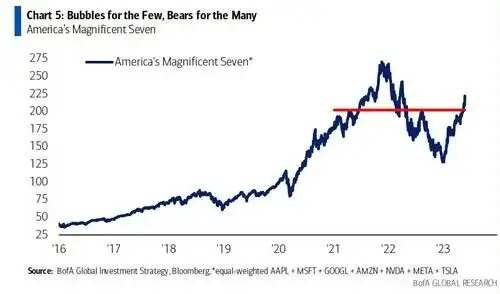Up over 20% year-to-date, can NASDAQ continue to rise up?
The recent performance of the US stock market has been strong, with repeated new highs. In particular, the $Nasdaq Composite Index (.IXIC.US)$ has risen nearly 24% since the beginning of the year.
It's worth noting that US bond yields have been rising recently, with the $U.S. 10-Year Treasury Notes Yield (US10Y.BD)$ surpassing 3.8%. Worries about high inflation, interest rate hikes, recession, debt ceiling, and banking problems continue to arise from time to time, and the strong trend of the US stock market seems to be "perplexing" in contrast to the cautious views at the end of last year.
Is the new high a blind optimism that implies enormous risks? Or is it underestimating and ignoring structural opportunities within the market?
The characteristics of the new high
The recent performance of the US stock market has the following features:
1.Dominated by technology leaders
According to Bank of America statistics, since January, the median increase of seven major tech stocks including $Apple (AAPL.US)$, $Microsoft (MSFT.US)$, $Alphabet-A (GOOGL.US)$, $Amazon (AMZN.US)$, $NVIDIA (NVDA.US)$, $Meta Platforms (META.US)$, and $Tesla (TSLA.US)$ has been as high as 43%, almost five times that of the S&P 500 index; the average increase is 70%, while the other 493 stocks in the S&P 500 index have only increased on average by 0.1%.![]()

2.Valuation is the main contributor to the market's rise
From the perspective of valuation and earnings breakdown, according to CICC statistics, since mid-March, the $Nasdaq Composite Index (.IXIC.US)$ has risen by 16.5%, with a valuation contribution of 13.6% and an earnings contribution of 2.6%; among the 32% increase in tech leaders' stocks, the contribution of valuation is 20%, and earnings contribute 10%, which is higher than the overall market.
It can be seen that valuation is the main contributor to the market's rise.
The reasons for the new high
Despite rising expectations of interest rate hikes leading to an increase in risk-free rates, why has the US stock market not only been resilient but also led by interest rate-sensitive growth stocks? CICC believes that the main reasons are:
1.Macro credit cycle: The expansion of credit in the United States offsets the effect of monetary tightening, and the government's "bottom-up" support for the private sector significantly suppresses risk premiums, offsetting the rise in interest rates.
2.Structural mismatch in the US economy: Future recession pressures will be more reflected in service-oriented consumption, and the profit downgrades of tech companies were mostly completed last year.
3.Industry and company micro-level factors: AI technology trends lead the way, and head companies have stronger risk resistance capabilities compared to smaller companies due to their ability to cut costs and improve efficiency through layoffs.![]()
Is the US stock market in danger of becoming overvalued, and should investors approach it with caution?
Bloomberg data shows that when the $S&P 500 Index (.SPX.US)$ rises more than 8% in the past 100 trading days, its average increase for the year is over 25%. The S&P 500 index has risen more than 8.8% since the beginning of the year.

Of course, history will not simply repeat itself. The future direction of the US stock market will depend largely on the direction of the US recession and the pace of Fed interest rate hikes. CICC believes that:
1.In the base case, the US recession will put greater pressure on the earnings of cyclicals and value stocks in the US stock cycle, while the tech sector will be less affected.
2.If inflation exceeds expectations and the Federal Reserve raises interest rates more than expected, it will pose pressure on tech stocks from the denominator side.
3.If there is a severe turbulence due to unexpected risks, it is inevitable that there will be some pressure on tech stocks with higher profits. However, growth stocks will still benefit first after the Fed's easing shift.
What should we pay attention to next?
Before making the next interest rate decision on June 14th, the Fed will still analyze some important economic data.
For example, the May employment report will be released at 8:30 am Eastern Time this Friday. Early estimates from economists show that employment increased by 180,000 and the unemployment rate rose to 3.5%.
"If the data is hotter than expected, it almost locks in a June hike," said Mark Heppenstall, chief investment officer of Penn Mutual Asset Management.
Disclaimer: Moomoo Technologies Inc. is providing this content for information and educational use only.
Read more
Comment
Sign in to post a comment

102095132 : ok
1994CM : long term benefit.
modest Buffalo_77 : ok
Seekr : 16.5%, with a valuation contribution of 13.6% and an earnings contribution of 2.6%; among the 32% increase in tech leaders' stocks, the contribution of valuation is 20%, and earnings contribute 10%, which is higher than the overall market.
Seekr : whats the contritbution to the other 70 pts
xiaomitu : Super 7 Bull Run.
Chyemm : Good
amusing Python_2407 : cash withdrawal
101772986 :